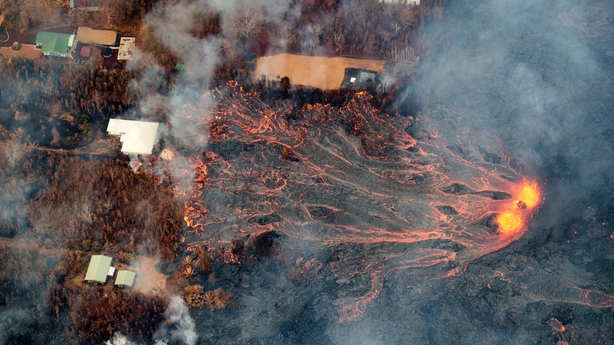A broad lava flow has crossed onto the property of a Hawaii geothermal power station, posing a new hazard as molten rock from the erupting Kilauea volcano bulldozes through homes and backyards.
The lava crossed onto the Puna Geothermal Venture (PGV) yesterday evening according to the US Geological Survey, having destroyed dozens of nearby houses in the past few days.
Since Hawaii's Kilauea volcano began a once-in-a-century-scale eruption on 3 May, authorities have shut down the plant, removed more than 60,000 gallons of flammable liquid, and deactivated wells that tap into steam and gas deep in the Earth's core.
Magma has drained from Kilauea's summit lava lake and flowed around 40km east underground, bursting out of about two dozen giant cracks or fissures near the plant.
"The flow from fissures 21 and 7 was widening and advancing," Janet Snyder, a spokeswoman for the County of Hawaii, said on the position of lava heading northeast towards PGV.
Hawaii Governor David Ige has said the wells are stable.

But lava has never engulfed a geothermal plant anywhere in the world and the potential threat is untested, according to the head of the state's emergency management agency.
Residents fear an explosive emission of deadly hydrogen sulfide and other gases should wells be ruptured.
Residents have complained of health hazards from emissions from the plant since it went online in 1989 and PGV has been the target of lawsuits challenging its location on the flank of one of the world's most active volcanoes.
The Israeli-owned 38 megawatt plant typically provides around 25% of electricity on the Big Island, according to local power utility Hawaii Electric Light.
Operator Ormat Technologies Inc last week said there was no above-ground damage to the plant but it would have to wait until the situation stabilised to assess the impact of earthquakes and subterranean lava flows on the wells.
In just the past 24 hours there were between 250 and 270 earthquakes at Kilauea's summit, with four explosions on Saturday sending ash to altitudes as high as 4,572m said officials said.
Winds are set to shift on Monday and Tuesday, causing higher concentrations of ash and volcanic smog that will spread west and northwest to affect more populated areas, National Weather Service meteorologist John Bravender said.
US Marine Corp and National Guard helicopters are on standby for an air evacuation in the event fissure activity cuts off Highway 130, the last exit route for up to 1,000 coastal residents.
Cracks in the highway have yet to emit hydrogen sulfide gas which would indicate magma was rising towards the surface.

